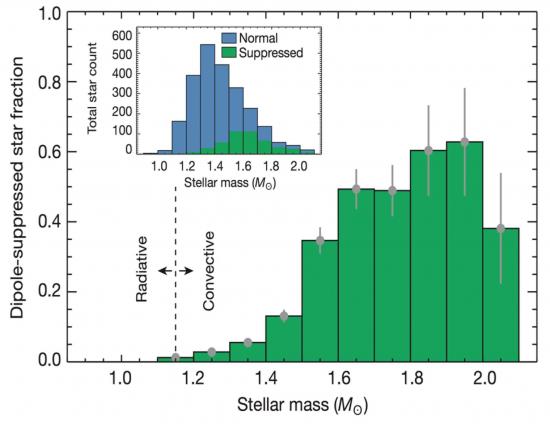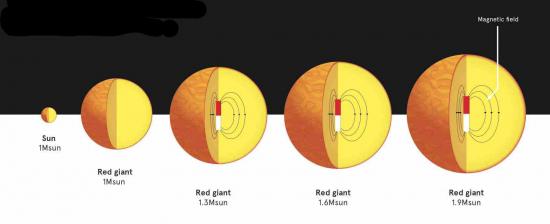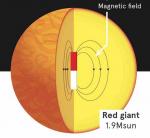An international collaboration, involving the Astrophysics Department-AIM Laboratory of CEA-IRFU, managed to determine, from asteroseismology, that up to 65% of stars more massive than the Sun (between 1.6 and 2 solar masses) have a very high internal magnetic field. So far, only 5-10% of these stars were suspected to have a magnetic field up to 10 million times that of Earth. This unexpected discovery demonstrates the importance of a "dynamo effect" able of maintaining intense fields in the interior of stars. These results, obtained using the Kepler satellite data [1], are published in the journal Nature on 21 January 2016.
Magnetic greenhouse effect
Using data from the NASA Kepler satellite, an international team of researchers was able to study about 13,000 red giant stars through the technique of asteroseismology, the measurement of vibrations inside and on the surface of the stars. Red giants are older and more massive stars than our Sun for which it is possible to measure seismic vibrations propagating down to their heart.
Recently published results from a small sample of red giants had already shown that strong magnetic fields can disrupt the propagation of gravity waves, which then remain trapped in the inner layers of the star in a phenomenon called "magnetic greenhouse effect". It is by measuring the amplitude of the oscillation modes, that the scientists found that in a large number of stars, about 65%, these modes were removed, implying the existence of large internal magnetic fields.

Fraction of stars showing a strong magnetic field according to their mass (in solar mass Mo). The proportion increases with the mass to achieve a fraction of 60% for stars between 1.8 and 2.0 Mo. The inset box shows the total number of observed stars (blue bars) and the number of stars with a strong internal magnetic field (green bars).
A revolution in the evolution of stars.
"This result was completely unexpected," says Rafael García of Astrophysics Department-AIM Laboratory "Until now, only a small number of stars with masses less than 2 solar masses had large measured magnetic fields. These large magnetic fields were completely unnoticed by researchers because they were hidden in the deepest heart of the stars. "
"It's very exciting," says Rafael García "because magnetic phenomena will change the properties of the interiors of stars and we have neglected them so far in the current models of stellar structure and evolution."

The stars of mass lower than 1.1 Mo, do not develop strong magnetic fields in their heart. Only the stars of masses greater than 1.1 Mo, for which a convective core grows, the magnetic field is large enough to be detected. For stars between 1.6 and 2 solar masses, 50 and 65% of the stars studied show the signature of strong magnetic fields in their center. This finding implies that for these stars, the magnetic field is most likely of dynamo origin. Credits Sydney University
This major discovery, which affects more than half of the stars in this range of masses, has yet unassessed implications. The results will enable scientists to test more directly their theories about how magnetic fields form and evolve within the stars - a process known as the dynamo effect. This could lead to a better general understanding of the magnetic dynamos, including control of the magnetic dynamo responsible for the 22 years cycle of the Sun, which is known to affect the communication systems and cloud cover on Earth.
Contact: Rafael GARCIA
Publication: « A prevalence of dynamo-generated magnetic fields in the cores of intermediate-mass stars », Dennis Stello, Matteo Cantiello, Jim Fuller, Daniel Huber, Rafael A. García, Timothy R. Bedding, Lars Bildsten & Victor Silva Aguirre,
published in Nature on 21 January 2016
Electronic version : :  PDF File (http://arxiv.org/abs/1601.00004)
PDF File (http://arxiv.org/abs/1601.00004)
Notes :
[1] The NASA Kepler satellite, launched in March 2009, is devoted to the search of exoplanets around nearby stars. It can measure tiny luminosity variations and then detect star oscillations.
see
See : the Université of Sydney Press Release (21 January 2016)
t the CNES news (Centre National d'Etudes Spatiales) (21 January 2016)
See also :
- The magnetic core of the red giants (23 Octobre 2015)
- The stars rotate more slowly with age (01 January 2015)
- The heart of the giant stars reveal their source of energy (30 March 2011)
- Asteroseismology and Magnetic Activity (26 August 2010)
- Starquakes (01 March 2010)
See : Communication du Service d'Astrophysique
Redaction : Rafael Garcia, Jean-Marc Bonnet-Bidaud
• Structure and evolution of celestial bodies
• Department of Astrophysics (DAp) // UMR AIM
• Dynamics of Stars, Exoplanets and their Environment
• Kepler




